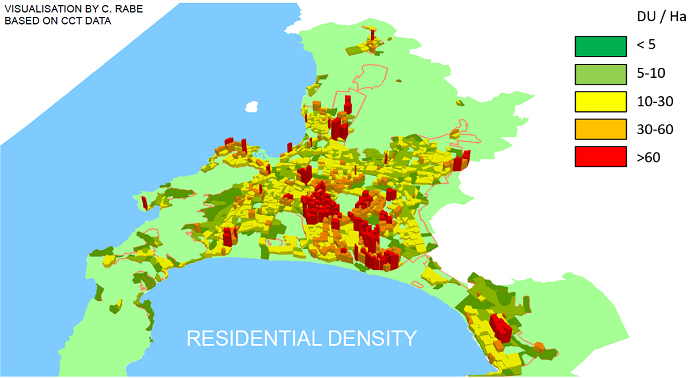How to recreate the city of Cape Town
06 April 2017 | Photos Supplied by the Integration Syndicate, an African Centre for Cities initiative.
Why has it been so difficult to reshape our cities and to move away from the legacy of apartheid?
“More than two decades after democracy the legacy of spatial segregation persists. The truth is we have no practical idea how to undo and remake the legacy of spatial inequality within the constraints of private property and existing real estate market dynamics. Worse, our public policies, although well-intentioned, have exacerbated the problem. Social housing policies have seen low-cost housing built further and further out on the periphery of cities, far from transport nodes, from jobs or other economic opportunities”.
This is the observation of Professor Edgar Pieterse, head of the African Centre for Cities (ACC) at the University of Cape Town, on the eve of the official launch of the Integration Syndicate (IS) – a partnership including public policy research centres at three Western Cape universities, policymakers, and civil society groups.
The IS will be launched tomorrow, 06 April 2017, as a year-long project to find practical ways to reshape the city of Cape Town.
The problem of spatial segregation has come at great cost, not only financial – an RDP house costs much more than the subsidy provided of R90 000 – but also social. Our social cohesion as a society is undermined daily by the persistence of geographic apartheid, the long and expensive commutes that those who earn the least must endure, and the generally unsafe nature of the townships where most citizens still live, notes Professor Pieterse.

Spatial segregation, inequality and exclusion have recently burst into the public sphere in Cape Town through a series of campaigns drawing attention to the sale of publicly owned land and the humanitarian impacts of gentrification processes. There is deep public interest in understanding why it is so difficult to shift stubborn spatial patterns and what can practically be done to effect any meaningful change on the ground.
The IS is convened by the Cape Higher Education Consortium and led by the ACC. It is partnered by UCT’s Poverty and Inequality Initiative, the Centre for Humanities Research at the University of the Western Cape, and the Centre for Complex Systems in Transition at the University of Stellenbosch.
The ACC, under the leadership of internationally renowned urban development expert Professor Pieterse, has for several years been running the CityLab project which facilitates policy discussion on how to reverse the legacy of spatial apartheid and foster urban sustainability.
The IS builds on this. It will entail a series of ten “episodes”, run once a month, to spark informed debate about the drivers of spatial injustice and more importantly, to find remedies.
This is an opportunity for policy makers at all levels of government, civil society organisations and researchers to find ways to recreate the city of Cape Town.
The intention is to establish a permanent space where discussions will be hosted. The conversations will unfold amidst a heavy reliance on maps, information graphics and other data sources that will allow anyone to participate in the debate but also avoid the risks of standoffs on the basis of ideology alone. The participants will include leaders from the public sector, social movements, NGOs, academia and the private sector.
The ten episodes will unfold over a year and culminate in a public conference in March 2018 where the findings of the Syndicate will be presented.
The sequence of discussions and the dates of each workshop are as follows:
- Episode 1: (6 April)
What is integration and can it be achieved within the next generation? - Episode 2: (4 May)
Geo-historical roots of segregation and fragmentation. Can we imagine an alternative city which will lay the basis for a more inclusive future? - Episode 3: (1 June)
What are the economic drivers of inclusion/exclusion and spatial inequality? What will it take to achieve inter-generational economic empowerment? - Episode 4: (6 July)
The practical building blocks of integration: a focus on three geographic points that are already on the priority list of the public sector - Episode 5: (3 August)
Case study: Two Rivers Urban Park acupuncture point - Episode 6: (31 August)
Case Study: Philippi transit-oriented development hub acupuncture point - Episode 7: (5 October)
Case Study: Bellville transit-oriented development hub acupuncture point - Episode 8: (2 November)
Weaving the cases and other sites of opportunity for the next decade (drawing on Voortrekker Road Corridor) - Episode 9: (7 December)
Kaapse innovation: Popularising and embedding integration in the public sphere of the city - Episode 10: (25 January 2018)
How to embed the integration in the public realm
The IS aims to create a broader, more nuanced and inclusive policy community, as well as more effective action across diverse political and institutional settings in the city.
The organisers hope this will induce a better quality public debate, more effective policy priorities, and a larger network of informed and passionate urbanists across diverse fissure lines of the city.
For enquiries or to arrange interviews with Professor Edgar Pieterse, please contact Heeten Bhagat (cell: 081 816 0295) or Maryam Waglay at 021 650 5903.
 This work is licensed under a Creative Commons Attribution-NoDerivatives 4.0 International License.
This work is licensed under a Creative Commons Attribution-NoDerivatives 4.0 International License.
Please view the republishing articles page for more information.










